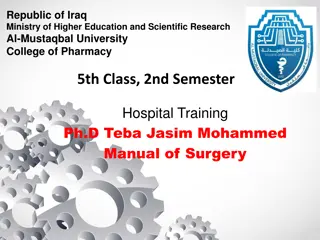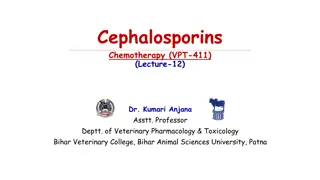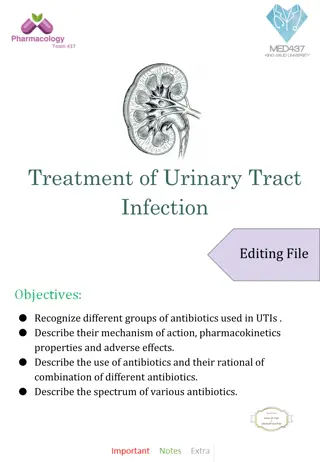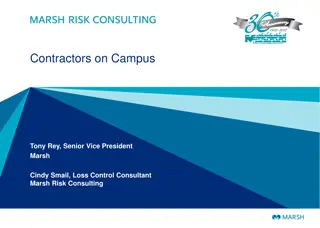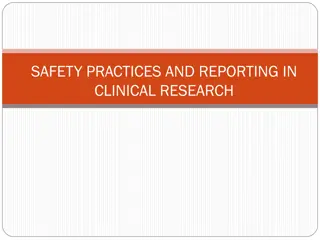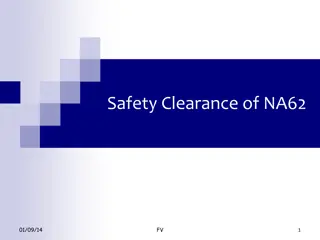Cephalosporins: Types, Safety, and Effects
Cephalosporins, derived from Acremonium mold, are broad-spectrum antibiotics effective against various bacterial infections. Explore the types, safety profile, and side effects of these antibiotics to understand their usage and impact.
Download Presentation

Please find below an Image/Link to download the presentation.
The content on the website is provided AS IS for your information and personal use only. It may not be sold, licensed, or shared on other websites without obtaining consent from the author.If you encounter any issues during the download, it is possible that the publisher has removed the file from their server.
You are allowed to download the files provided on this website for personal or commercial use, subject to the condition that they are used lawfully. All files are the property of their respective owners.
The content on the website is provided AS IS for your information and personal use only. It may not be sold, licensed, or shared on other websites without obtaining consent from the author.
E N D
Presentation Transcript
StudyMafia.Org Cephalosporins Submitted To: Submitted By: Studymafia.org Studymafia.org
Table Contents Definition Introduction Why Cephalosporins? Types of Cephalosporins Are Cephalosporins Safe? Side Effects of Cephalosporins Conclusion 2
Definition Cephalosporins are a large group of antibiotics derived from the mold Acremonium (previously called Cephalosporium). Cephalosporins are bactericidal (kill bacteria) and work in a similar way to penicillins. 3
Introduction They are called broad-spectrum antibiotics because they are effective against a wide range of bacteria. Since the first cephalosporin was discovered in 1945, scientists have been improving the structure of cephalosporins to make them more effective against a wider range of bacteria. 4
Why Cephalosporins ? Cephalosporins may be used to treat infections caused by susceptible bacteria, such as: Bone infections Ear infections (eg, otitis media) Skin infections Upper respiratory tract infections Urinary tract infections. Cephalosporins are not usually used as a first-choice antibiotic. 5
Types of Cephalosporins First generation cephalosporins First generation cephalosporins refer to the first group of cephalosporins discovered. Their optimum activity is against gram-positive bacteria such as staphylococci and streptococci. They have little activity against gram-negative bacteria. 6
Types of Cephalosporins Second generation cephalosporins Second-generation cephalosporins are more active against gram-negative bacteria, with less activity against gram- positive bacteria. 7
Types of Cephalosporins Third generation cephalosporins Third generation cephalosporins followed the second-generation cephalosporins. Cefotaxime and ceftizoxime (discontinued) offer the best gram-positive coverage out of all the third-generation agents; ceftazidime and cefoperazone (discontinued) are unique in that they provide antipseudomonal coverage. 8
Types of Cephalosporins Fourth generation cephalosporins Fourth generation cephalosporins are structurally related to third-generation cephalosporins but possess an extra ammonium group, which allows them to rapidly penetrate through the outer membrane of gram-negative bacteria, enhancing their activity. 9
Types of Cephalosporins Next (fifth) generation cephalosporins It is active against methicillin-resistant Staphylococcus aureus (MRSA) and gram- positive bacteria. It also retains the activity of the later- generation cephalosporins and is effective against susceptible gram-negative bacteria. 10
Are Cephalosporins Safe? Cephalosporins are generally safe, with low toxicity and good efficacy against susceptible bacteria. Allergic reactions have been reported with cephalosporins and symptoms may include a rash, hives (urticaria), swelling, or rarely, anaphylaxis. 11
Are Cephalosporins Safe? Up to 10% of people with a history of penicillin allergy will also be allergic to cephalosporins. Rarely, seizures have been reported with some cephalosporins; the risk is greatest in those with kidney disease. 12
Are Cephalosporins Safe? Cephalosporins have also been associated with a reduced ability of the blood to clot leading to prolonged bleeding times. People with kidney or liver disease, nutritionally deprived, taking cephalosporins long-term, or concurrently receiving anticoagulant therapy are more at risk. 13
Side Effects of Cephalosporins Cephalosporins generally cause few side effects. The most common side effects reported include abdominal pain, diarrhea, dyspepsia, headache, gastritis, and nausea and vomiting. Transient liver problems have also been reported. 14
Side Effects of Cephalosporins Rarely, some people may develop a super-infection due to overgrowth of a naturally occurring bacterium called Clostridium difficile, following use of any antibiotic, including cephalosporins. Symptoms may include severe diarrhea. 15
Conclusion Cephalosporins are beta-lactam antimicrobials used to manage a wide range of infections from gram-positive and gram-negative bacteria. The five generations of cephalosporins are useful against skin infection, resistant bacteria, meningitis, and other infections. 17
Thanks To StudyMafia.org




